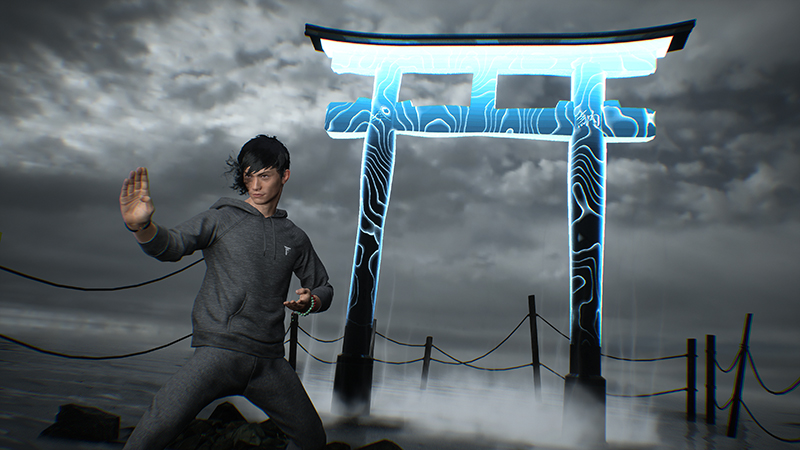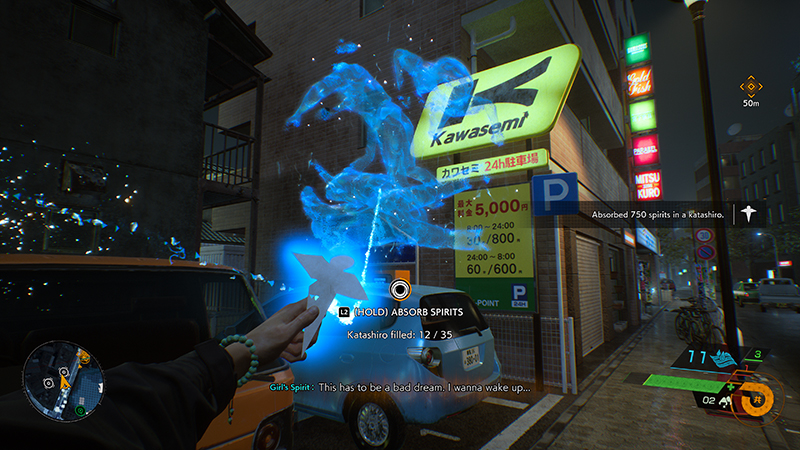Ghostwire: Tokyo is a big shift from Tango Gameworks’ other games, as well as shooters as a whole. While the team built its name on the horror series The Evil Within, this newest title only has vague horror elements. And speaking more broadly, most first-person shooters are about blasting shotguns and ripping and tearing and Ghostwire: Tokyo is about elaborately flinging spells as if each finger were its own individual gun barrel. Breaking free from tradition and industry tropes does wonders for the game, resulting in an experience that is able to carve its own path and stick out amongst a sea of dull open-world games and shooters.
Ghostwire’s combat plays a key role in its uniqueness, as its Ethereal Weaving, as it is dubbed, is unlike anything else. Its wind, water, and fire powers very loosely stand in for more traditional firearms — the pistol, shotgun, and rocket launcher, respectively — and gain secondary functions when charged up. More variety would have been welcome, but these spells (along with the stealthy bow and arrow and various consumable special talismans) broadly cover the bases and mean players will have a tool for most situations.

The magic in this, well, magic-based loop is how its smaller and disparate systems work in tandem with one another to create one great whole. Hand gestures are beautifully animated, almost perfectly straddling the line between expressive and responsive as protagonist Akito conjures up and tosses his offensive spells. Whipping out fireballs is as smooth and exaggerated as it needs to be, which is taken to the extreme with its core-extracting mechanic.
Players can violently pull or crush the cores from weakened enemies with a system akin to Doom’s Glory Kills by twisting their hands and using a cat’s cradle-like motion inspired by Kuji-kiri, a traditional, gesture-based form of exorcism or protection. The dramatic animation coupled with sound effects that appropriately escalate as the tension in the titular ghostly wire builds ensure that this fundamental motion is consistently satisfying to pull off; the ammo and health earned back are almost just nice bonuses instead of the main reasons to rip out cores. Perfectly timing a block is similarly exciting, as it is accentuated with a brief but pleasing bit of slow motion.
Encounters become rhythmic dances of avoiding or blocking melee hits and projectiles and finding the right opportunity to strike back and grab exposed cores. Getting into that groove is rewarding because of how the flamboyant animations, smooth controls (however, the default sensitivity options are terribly sluggish), and punchy sound effects all combine to create a combat system that pushes many of the right buttons. It can get a little repetitive since it doesn’t have the most expansive toolset, but that repetition is mostly masked by its unique nature and the satisfaction that comes with getting into its aforementioned rhythm.
Blocking works for what the game throws at players, but walking backward ends up being the most useful defensive tool. While players have to avoid cornering themselves, merely backpedaling can counter just about everything. There’s also no dodge or sidestep, but there’s also no need for one since the enemies were built with that limitation in mind. But that’s part of the problem: They don’t have swift strikes because the player wouldn’t be able to avoid them without an evasive quickstep. It’s smart that their offensive abilities were made in tandem with the player’s defensive ones, but it results in a system with one unfailing tactic that pushes players to disengage rather than engage. Faster attacks and an accompanying evasive maneuver could crank up the pacing and counter the unbeatable strategy of constantly reversing. It doesn’t deal a fatal blow to the combat; it’s just a small missed opportunity.

The enemies themselves are spectacular, regardless of their speed. Tango has conjured up a lineup full of spirits that, like the very best monsters, excel because of their captivating designs that oscillate between being beautiful and chilling. Some, such as the Slenderman-like Rain Walkers and childlike Students of Misery, are original creations that take ordinary parts of Japanese culture (like businessmen and uniformed schoolchildren, respectively) and push them through a twisted filter, merging the supernatural and natural in creative ways.
Others are Tango’s interpretations of classic yōkai. These are where the creepier designs rear their ugly heads and are most notably seen in the scissor-wielding Kuchisake and big-mouthed Lamentation (that seems to be based on the unsettling Itsuki yōkai). Tango is seemingly proud of its handiwork, as stealth kills and physical core grabs often provide close-ups of these haunting characters. While combat is generally exciting most of the time, the imaginative enemy design surely plays a part in that, too. Not all of them are hostile, though, and the friendlier beasts, while sticking mainly to more traditional renditions, balance out all the spooky spirits wandering around. It’s also just charming to see a cute, floating cat selling real-life Japanese snacks in a convenience store or food stand.

Ghostwire’s respect for Japanese culture goes far past its adaptations of mythological beings. The setting is the biggest example of this, as it stars the brightly lit and ever-beautiful Shibuya ward in Tokyo, but it doesn’t just feel like any other video game city. Instead, Ghostwire’s version of the area feels more like an actual place since it includes iconic landmarks like the Shibuya Scramble Crossing as well as smaller suburbs, rural regions, and everything in between. It’s not just a highlight reel since it’s got all sorts of unexciting small housing areas and mundane alleyways, too. Abandoned (and anxious) dogs, crashed cars, empty stores with blaring pop music, and piles of clothes are also all traces that show how lived-in the world is, even if it is brought to life by the things those departed people left behind.
This setup makes wandering around more akin to virtual tourism instead of just being a landmass to hurriedly run through, as is the case with many open-world games. Almost any other of those open-world titles would rightfully be derided if they were constructed like this, especially since Ghostwire’s map is cluttered with the types of small quests and collectibles that have grown increasingly tiresome over the years. But Ghostwire eludes this criticism for the most part because those mindless activities like map clearing and collectible hunting are excuses to check out its interesting location rather than just being bloat for bloat’s sake.

The collectibles themselves also function as even more extensions of this game’s appreciation for Japan’s history. From 17th-century Ukiyo-e art to baggy socks that were popular in the 1990s, they’re all cultural artifacts that are more than just nameless doodads and, through helpful journal entries, paint an intricate picture of the country. There are even 240,300 spirits to collect, which seems like a horribly inflated and arbitrary number, but is Shibuya’s estimated population. Spirits usually come in large, multi-hundred bundles and even though it’s still quite an overwhelming number to track down, it shows Tango’s undying commitment to accuracy and respect for its source material.
Collecting 240,300 spirits is somehow less mind-numbing than the actual story. Akito’s mission to save his sister and, by extension, Tokyo is almost absent of any buildup and makes pretty large leaps that players are just meant to accept. Huge bits of necessary backstory for everyone involved are glossed over or entirely absent, resulting in yet another game that tells players they should care without doing the legwork to actually get them to.
The critical path cuts out a lot of other steps and results in half of a plot that revs up quickly before abruptly slamming on the brakes. Ghostwire is much, much shorter than other open-world games, which is relieving in some regard, but that brevity comes at the cost of its narrative. While it does flirt with some touching themes of death and loss and has genuinely funny dialogue at times, all of these problems show that Tango’s storytelling skills are as anemic as ever.
Ghostwire: Tokyo is more than its sloppy story and is a one-of-a-kind shooter that doubles as a paranormal trip to Tokyo. Clearing out scores of inventive beasts with a handful of impressively animated spells is often exhilarating, as is exploring Shibuya’s drenched and detailed nooks and crannies. It is prone to repetition, but it ends up being more soothing than exhausting. Ghostwire: Tokyo isn’t Bethesda Softworks’ best first-person shooter, but it still earns its spot within that publisher’s peerless shooter pantheon through the sheer ingenuity found in its mechanics and world.
SCORE: 8/10
As ComingSoon’s review policy explains, a score of 8 equates to “Great.” While there are a few minor issues, this score means that the art succeeds at its goal and leaves a memorable impact.










